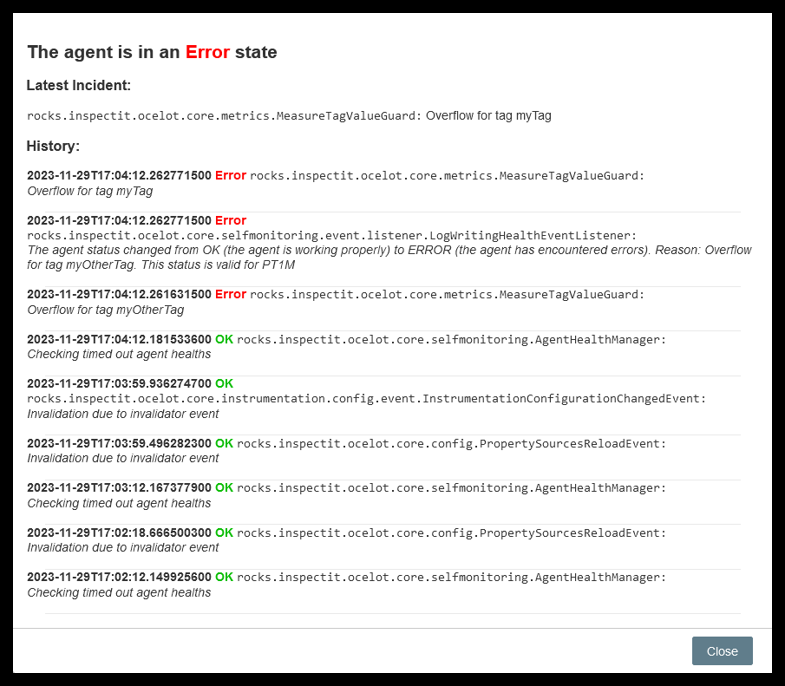Tag-Guard
Since version 2.6.0 it is possible to limit the amount of tag values of metrics.
This can be useful for controlling the amount of tag values, which will be written to your time series database
(e.g. InfluxDB or Prometheus). A high amount of unique tag values for a metric will result in a high cardinality,
which in turn might lead to performance or memory issues in your time series database.
The recorded tag values for each measure of an agent will be stored inside a local JSON file. This file serves as the tag-guard-database and helps to check, if tag values exceeded their limit.
Configuration
You can set the Tag-Guard configuration in inspectit.metrics.tag-guard.
| Property | Default | Description |
|---|---|---|
.enabled | true | Only when the tag-guard is enabled, the tag value limits will be checked. |
.database-file | ${inspectit.env.agent-dir}/${inspectit.service-name}/tag-guard-database.json | The location of the JSON file with all recorded tag values. |
.schedule-delay | 30s | The delay for the scheduler, which will regularly compare the tag-guard-database with the configured tag value limits. |
.overflow-replacement | TAG_LIMIT_EXCEEDED | After exceeding it's configured tag value limit, every tag will use this overflow replacement as value. |
.max-values-per-tag | 1000 | The global tag value limit for every measure. |
.max-values-per-tag-by-measure | {} | A map with measure names as key and their specific tag value limit as value. |
There are three ways to define a tag value limit for measures. They are prioritized in the following order:
- Inside a metric definition for a particular measure
- Globally for specific measures via
may-values-per-tag-by-measure - Globally for all measures via
max-values-per-tag
This means that a tag value limit inside a metric definition will overwrite all other tag value limits
for the particular metric. A configured tag value limit in max-values-per-tag-by-measure will only overwrite the
globally set tag value limit in max-values-per-tag for the particular measure, but not a configured tag value limit
inside the metric definition. Let's look at an example:
inspectit:
metrics:
tag-guard:
max-values-per-tag: 1000
max-values-per-tag-by-measure:
my_metric: 200
In this configuration the global tag value limit is set to 1000, which means that every measure can only record 1000 unique
tag values for each tag. However, this does not apply to the measure my_metric, because the global tag value limit is
overwritten by max-values-per-tag-by-measure with 200. Thus, the measure my_metric can only record a maximum of 200 unique
tag values for each tag.
Now, let's add another configuration:
inspectit:
metrics:
definitions:
'my_metric':
tag-guard: 100
This metric definition will overwrite the tag value limit specified in max-values-per-tag-by-measure for the measure my_metric,
resulting in a tag value limit of 100. Every other measure still uses the globally configured tag value
limit of 1000.
Agent Health Monitoring
If the tag value for a specific agent is exceeded, the Tag-Guard scheduler will detect an overflow and change
the agent health to ERROR.
Additionally, an agent health incident will be created, mentioning which tag-key has exceeded its tag value limit.
In the Agent Status Table View of the Configuration-Server you can click on the
health state icon of a particular agent to view its last agent health incidents. You can set the amount of buffered incidents
with inspectit.self-monitoring.agent-health.incident-buffer-size. A list of incidents could look like this:

How To Fix A Tag Value Overflow
If a tag value limit was exceeded, there are two options to resolve the agent health ERROR.
The first option would be to increase the tag value limit. Probably the limit has been estimated too low and thus has
to be increased. After increasing the tag value limit, the tag-guard-database scheduler will resolve the ERROR.
The second option would be to adjust your configuration or application so the tag value limit should not be exceeded anymore.
After the adjustment, you will have to "reset" the recorded tag values in the tag-guard-database to resolve the ERROR.
One way to reset the tag-guard-database is to delete the local JSON file. However, this will delete all recorded tag values
and might not be the preferred solution.
A more preferable solution would be to only reset the tag values for a specific tag of a measure,
which has exceeded its tag value limit.
To do this, you could use the jq command-line JSON processor, which has to be installed on your system manually.
For example, you could use the following command, if you would like to delete all recorded tag values for the tag my_tag inside the measure my_metric:
- Unix:
jq '.my_metric.my_tag = []' tag-guard-database.json > temp.json && mv temp.json tag-guard-database.json - Windows:
jq ".my_metric.my_tag = []" tag-guard-database.json > temp.json && move temp.json tag-guard-database.json
In future versions of inspectIT there might be an option to reset specific tag values directly in the Configuration-Server UI.
